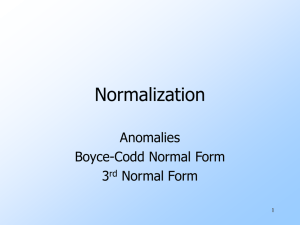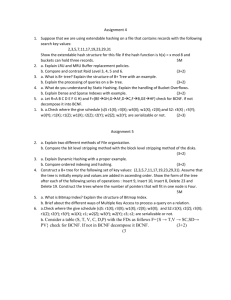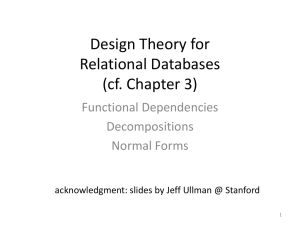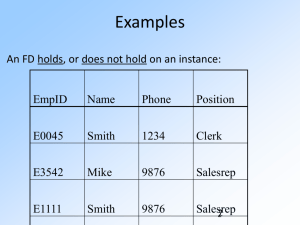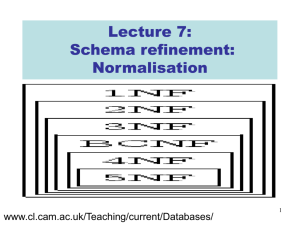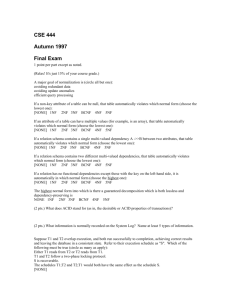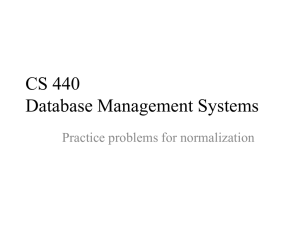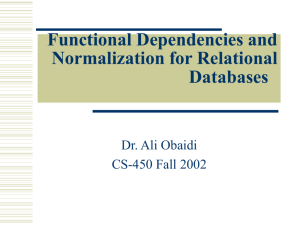ppt
advertisement
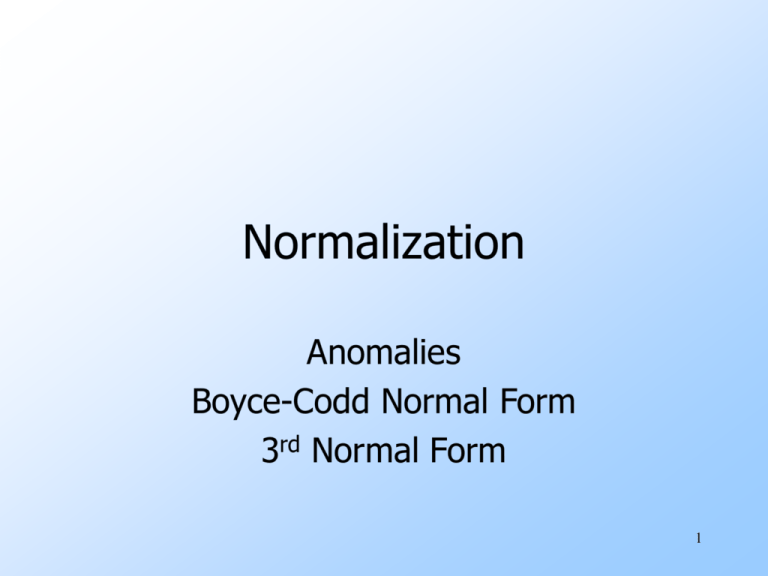
Normalization
Anomalies
Boyce-Codd Normal Form
3rd Normal Form
1
Anomalies
Goal of relational schema design is to
avoid anomalies and redundancy.
Update anomaly : one occurrence of a fact
is changed, but not all occurrences.
Deletion anomaly : valid fact is lost when a
tuple is deleted.
2
Example of Bad Design
Drinkers(name, addr, beersLiked, manf, favBeer)
name
Janeway
Janeway
Spock
addr
Voyager
???
Enterprise
beersLiked
Bud
WickedAle
Bud
manf
A.B.
Pete’s
???
favBeer
WickedAle
???
Bud
Data is redundant, because each of the ???’s can be figured
out by using the FD’s name -> addr favBeer and
beersLiked -> manf.
3
This Bad Design Also
Exhibits Anomalies
name
Janeway
Janeway
Spock
addr
Voyager
Voyager
Enterprise
beersLiked
Bud
WickedAle
Bud
manf
A.B.
Pete’s
A.B.
favBeer
WickedAle
WickedAle
Bud
• Update anomaly: if Janeway is transferred to Intrepid,
will we remember to change each of her tuples?
• Deletion anomaly: If nobody likes Bud, we lose track
of the fact that Anheuser-Busch manufactures Bud.
4
Boyce-Codd Normal Form
We say a relation R is in BCNF if
whenever X ->A is a nontrivial FD that
holds in R, X is a superkey.
Remember: nontrivial means A is not a
member of set X.
Remember, a superkey is any superset of
a key (not necessarily a proper superset).
5
Example
Drinkers(name, addr, beersLiked, manf, favBeer)
FD’s: name->addr favBeer, beersLiked->manf
Only key is {name, beersLiked}.
In each FD, the left side is not a
superkey.
Any one of these FD’s shows Drinkers
is not in BCNF
6
Another Example
Beers(name, manf, manfAddr)
FD’s: name->manf, manf->manfAddr
Only key is {name} .
name->manf does not violate BCNF, but
manf->manfAddr does.
7
Decomposition into BCNF
Given: relation R with FD’s F.
Look among the given FD’s for a BCNF
violation X ->B.
If any FD following from F violates BCNF,
then there will surely be an FD in F itself
that violates BCNF.
Compute X +.
Not all attributes, or else X is a superkey.
8
Decompose R Using X -> B
Replace R by relations with schemas:
1. R1 = X +.
2. R2 = R – (X
+
– X ).
Project given FD’s F onto the two
new relations.
9
Decomposition Picture
R1
R-X +
X +-X
X
R2
R
10
Example
Drinkers(name, addr, beersLiked, manf, favBeer)
F = name->addr,
name -> favBeer,
beersLiked->manf
Pick BCNF violation name->addr.
Close the left side: {name}+ = {name, addr,
favBeer}.
Decomposed relations:
1. Drinkers1(name, addr, favBeer)
2. Drinkers2(name, beersLiked, manf)
11
Example, Continued
We are not done; we need to check
Drinkers1 and Drinkers2 for BCNF.
Projecting FD’s is easy here.
For Drinkers1(name, addr, favBeer),
relevant FD’s are name->addr and
name->favBeer.
Thus, {name} is the only key and Drinkers1
is in BCNF.
12
Example, Continued
For Drinkers2(name, beersLiked, manf),
the only FD is beersLiked->manf, and
the only key is {name, beersLiked}.
Violation of BCNF.
beersLiked+ = {beersLiked, manf}, so
we decompose Drinkers2 into:
1. Drinkers3(beersLiked, manf)
2. Drinkers4(name, beersLiked)
13
Example, Concluded
The resulting decomposition of Drinkers :
1. Drinkers1(name, addr, favBeer)
2. Drinkers3(beersLiked, manf)
3. Drinkers4(name, beersLiked)
Notice: Drinkers1 tells us about drinkers,
Drinkers3 tells us about beers, and
Drinkers4 tells us the relationship between
drinkers and the beers they like.
14
Third Normal Form - Motivation
There is one structure of FD’s that
causes trouble when we decompose.
AB ->C and C ->B.
Example: A = street address, B = city,
C = zip code.
There are two keys, {A,B } and {A,C }.
C ->B is a BCNF violation, so we must
decompose into AC, BC.
15
We Cannot Enforce FD’s
The problem is that if we use AC and
BC as our database schema, we cannot
enforce the FD AB ->C by checking
FD’s in these decomposed relations.
Example with A = street, B = city, and
C = zip on the next slide.
16
An Unenforceable FD
street
zip
545 Tech Sq. 02138
545 Tech Sq. 02139
city
Cambridge
Cambridge
zip
02138
02139
Join tuples with equal zip codes.
street
city
545 Tech Sq. Cambridge
545 Tech Sq. Cambridge
zip
02138
02139
Although no FD’s were violated in the decomposed relations,
FD street city -> zip is violated by the database as a whole.
17
3NF Let’s Us Avoid This Problem
3rd Normal Form (3NF) modifies the
BCNF condition so we do not have to
decompose in this problem situation.
An attribute is prime if it is a member of
any key.
X ->A violates 3NF if and only if X is not
a superkey, and also A is not prime.
18
Example
In our problem situation with FD’s
AB ->C and C ->B, we have keys AB
and AC.
Thus A, B, and C are each prime.
Although C ->B violates BCNF, it does
not violate 3NF.
19
More Examples
R(A, B, C, D) with FDs: AB->C, C->D, D->A
Find all the non-trivial FDs w/ closure test
A+ = A, B+=B, C+=CDA, D+=DA
AB+=ABCD, AC+=ACD, AD+=AD,
BC+=ABCD, BD+=ABCD, CD+=ACD
Ignore ABC, ABD, BCD b/c they are superkeys
ACD+=ACD
New non-trivial FDs: C->A, AB->D, AC->D,
BC->AD, BD->AC, CD->A
20
More Examples (cont’d)
Find all the keys: AB, BC, BD
FDs that violate the BCNF
C->D, D->A, C->A, AC->D, CD->A
Decomposition using C->D: BC, ACD
No non-trivial FDs on BC, satisfies BCNF
Any two-attribute relation is always BCNF
FDs on ACD: C->D, D->A, C->A, AC->D, CD->A
Keys: C
D->A violates BCNF, further decompose into AD and CD
Final results: AD, BC and CD
21
More Examples (cont’d)
Find all the keys: AB, BC, BD
FDs that violate the BCNF
C->D, D->A, C->A, AC->D, CD->A
Decomposition using D->A: BCD, AD
FDs on BCD: C->D, BC->D, BD->C
Keys: BC, BD
C->D violates BCNF, further decompose into BC
and CD
Final results: AD, BC, and CD
22
More Examples on 3NF
R(A, B, C, D) with FDs: AB->C, C->D, D->A
Find all the non-trivial FDs w/ closure test
New non-trivial FDs: C->A, AB->D, AC->D,
BC->AD, BD->AC, CD->A
Find all the keys: AB, BC, BD
All satisfies the 3NF
23
What 3NF and BCNF Give You
There are two important properties of a
decomposition:
1. Recovery : it should be possible to project
the original relations onto the decomposed
schema, and then reconstruct the original.
2. Dependency Preservation : it should be
possible to check in the projected relations
whether all the given FD’s are satisfied.
24
3NF and BCNF, Continued
We can get (1) with a BCNF decomposition.
Explanation needs to wait for relational algebra.
We can get both (1) and (2) with a 3NF
decomposition.
But we can’t always get (1) and (2) with a
BCNF decomposition.
street-city-zip is an example.
25
Homework Question 3.6.1
R(ABCDE) with FD’s AB->C, C->D, D->B, D->E
Compute the closures:
A+=A, B+=B, C+=BCDE, D+=BDE, E+=E
AB+=ABCDE, AC+=ABCDE, AD+=ABCDE, AE+=AE,
BC+=BCDE, BD+=BDE, BE+=BE, CD+=BCDE,
CE+=BCDE, DE+=BDE
BCD+=BCDE, BCE+=BCDE, BDE+=BDE,
CDE+=BCDE, BCDE+=BCDE
Keys: AB, AC, AD
All BCNF violations (the minimal basis)
C->B, C->D, C->E, D->B, D->E
26
Homework Question 3.6.1 (II)
Decompose with C->B: AC and BCDE
Is BCDE in BCNF?
Key: C
Violating FD’s: D->B, D->E
Decompose into: CD, BDE
Final BCNF relations: AC, CD and BDE
Is R in 3NF?
Prime: A, B, C, D
Violating FD: C->E, D->E
27
Homework Question 3.6.1 (III)
Decompose into 3NF with C->E: AC, BCDE
Is BCDE in 3NF?
• Key: C
• Violating FD’s: D → B, D → E
• Decompose into: CD and BDE
Final results: AC, CD and BDE
Decompose into 3NF with D->E: ACD, BDE
Is ACD in 3NF?
• Key: AC and AD, so every attribute is prime.
Is BDE in 3NF?
• Key: D. Only FD’s: D->B, D->E, so yes
Final results: ACD and BDE
28
